The Ultimate Guide to Kerkyra
Corfu Old Town, also known as Kerkyra, is a captivating old city that seamlessly blends Venetian, French, and British influences with rich Greek traditions.
Located on the island of Corfu in the Ionian Sea, this UNESCO World Heritage Site features a maze of narrow cobblestone streets, historic buildings, and picturesque squares that highlight its diverse cultural heritage.
Whether you’re a history enthusiast, a foodie, or a beach lover, Kerkyra offers something for everyone.
Influences left by Conquerors
Corfu Old Town bears the marks of its long history of conquest. For 411 years, the Venetians ruled Corfu, leaving a lasting impact on its architecture and culture. As you explore the eastern part of the town, you’ll encounter a treasure trove of landmarks and monuments.
Strategically positioned between the New Fortress to the west and the Old Fortress to the east, the town’s historic core reflects the influence of its various rulers. The Venetian legacy is especially prominent, with numerous Italian architectural gems preserved throughout the city. Narrow alleyways known as “Kantounia,” towering old buildings, and scattered green spaces create a unique urban landscape reminiscent of a small Venice, minus the canals.
The Venetian influence is complemented by British remnants, such as the St. Michael and St. George Palace, and French touches, like Liston. Byzantine monuments, including the Old Fortress, also stand as a testament to the island’s ancient heritage.
Current Demographics
Today, Corfu town is home to around 45,000 residents, with approximately 20,000 living in the Venetian-style Old Town. Despite its high population density, the city offers ample employment opportunities, making it an attractive place for those looking to settle permanently.
Discovering Corfu Old Town

A photograph taken from the rooftop of the Cavalieri Hotel reveals a stunning panorama of Esplanade Square and the historic fortress of Corfu. The view extends from the Cofineta district in the north to North Garitsa Bay.
Landmarks such as the Palace of Saints Michael and George, the central kiosk, and the grandeur of the Old Fortress are notable highlights. It is often said that the best way to explore a destination is to wander and become pleasantly lost within its streets, a concept that perfectly applies to Corfu’s Old Town. While the town was predominantly shaped in the 19th century, its Venetian heritage is subtly interwoven throughout.
Stroll along cobblestone paths, peek into charming boutiques, and enjoy traditional delights at local shops or cafés. You may find yourself ascending a hill overlooking Corfu Bay, offering breathtaking views of the town below.
Visiting on Sundays
During the holiday season, particularly in summer, nearly all shops remain open, excluding public services. There is little distinction between Sundays and other days of the week, as the influx of visitors ensures that restaurants and cafes are consistently operational. Landmarks and monuments, including the fortresses, are also generally accessible.
Is Corfu Old Town worth visiting?
A visit to Corfu is incomplete without exploring its capital, Corfu Old Town. This UNESCO World Heritage Site is a remarkable city adorned with a plethora of monuments and historical sites, most notably from the Venetian era. Enclosed by the Old Fortress to the east and the New Fortress to the north and west, this area, known as Kastropolis, is unique in Greece.
Despite the island’s tumultuous history, the Old Town’s stately edifices, characterized by towering structures and slender alleys, have withstood the test of time. Built from stone and wood, these architectural marvels feature traditional tile-clad roofs that preserve the medieval essence of the city.
Districts of Corfu Old Town
Corfu Old Town is divided into seven distinct districts:
- Porta Remounta: The southern district near Garitsa Bay.
- Pentofanaro: Located in the Liston area.
- Kofineta: West of the Palace of St. Michael and George.
- Agioi Pateres: In the heart of the town.
- Jewish Sector: Near the New Fortress.
- Spilia: The area around the old port.
- Kampielo: The northern part of the Old Town.
Most streets within the Old Town are now pedestrian zones, with vehicular traffic limited to the outskirts. The main roads accommodating cars within the town center are Agoniston Polytechniou, Arseniou, Donzelot, and Zavitsianou streets.
Top Highlights and Attractions
Corfu Town is a place where every corner whispers stories from centuries past. Its winding streets, elegant architecture, and historic atmosphere offer a unique window into the island’s multicultural heritage.
If you’re curious to dive deeper into the landmarks that define this fascinating town, take a look at our full guide to Corfu’s top monuments and sights. 👉 Explore the monuments of Corfu Town
Gates of Old Kerkyra

The Old Town of Corfu was once enclosed by four main gates constructed during the Venetian period, each serving both defensive and administrative purposes.
These gates were vital for regulating access to the fortified city. Today, only the Porta of Spilia remains intact, standing as a testament to the town’s Venetian heritage.
The other gates, Porta San Nicola to the north, Porta San Rocco near the New Fortress, and Porta della Reale to the south, have been lost over time, but their historical significance continues to shape the narrative of the Old Town.
Remnants of English Rule
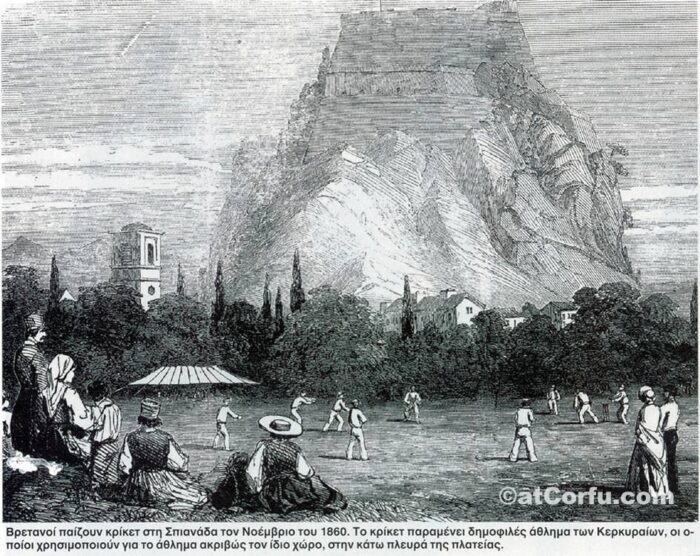
During British rule (1815–1864), Corfu saw significant changes and the introduction of new architectural styles, infrastructure, and cultural influences.
One of the notable constructions was the Peristyle of Thomas Maitland, a neoclassical colonnade located in the heart of Corfu Town. This peristyle, named after the first British Lord High Commissioner of the Ionian Islands, reflected the British affinity for classical Greek architecture and contributed to the island’s blend of styles.
The British also constructed Mon Repos Palace, originally built in 1828 as a summer residence for the British governors.
This elegant neoclassical palace later became the birthplace of Prince Philip, Duke of Edinburgh, and today serves as a museum and public park, offering visitors a glimpse into Corfu’s royal history.
On a more practical level, the British contributed significantly to the island’s infrastructure. They built an aqueduct that greatly improved the water supply to Corfu Town, addressing long-standing issues of water shortages. This engineering feat was vital for the growing population and helped modernize the town’s utilities.
Culturally, the British introduced several traditions, including the game of cricket, which remains popular on the island today. Corfu is one of the few places in Greece where cricket is still played, a direct legacy of British influence.
Another enduring tradition is the introduction of ginger beer, a beverage that quickly became a local favorite and is still produced and enjoyed in Corfu.
These developments—ranging from grand architectural projects to everyday cultural imports—left a lasting legacy on Corfu, blending British influence with the island’s rich Venetian and Greek heritage.
Museums
Corfu boasts a rich array of museums that offer a deep dive into its diverse cultural heritage.
- Archaeological Museum of Corfu: Located at 1 Vraila Armeni, houses an impressive collection of artifacts from ancient Corfu, including significant pieces from the Temple of Artemis, such as the famous Gorgon pediment. This museum is essential for understanding the island’s ancient history and its role in classical Greece.
- Byzantine Museum of Antivouniotissa: Situated at Arseniou 1, is housed in the historic Church of Antivouniotissa. It displays an extensive collection of Byzantine religious icons and artifacts from the 15th to the 19th centuries, offering valuable insights into the island’s Byzantine past and religious art.
- Museum of Asian Art: Located in the Palace of St. Michael and St. George. This museum features an exceptional collection of Asian art, with pieces from China, Japan, India, and other regions. It is unique in Greece for its exclusive focus on Asian cultural heritage.
- Solomos Museum, also on Arseniou 1, is dedicated to Dionysios Solomos, the national poet of Greece, and showcases his personal belongings, manuscripts, and letters. This museum provides a window into the life and work of Solomos, who penned the Greek national anthem.
- Casa Parlante Museum: Located at Nikorou Theotoki 16, it offers an immersive experience of 19th-century Corfu life. Through animated figures and period furnishings, visitors can explore the daily lives of Corfu’s aristocracy during the Venetian and British periods.
- Kapodistrias Museum: Located in Potamos, Corfu, is dedicated to Ioannis Kapodistrias, the first Governor of independent Greece. Situated in the former residence of Kapodistrias, the museum offers an in-depth look at his life and contributions to modern Greece. The museum features a range of exhibits, including personal artifacts, documents, and portraits that highlight Kapodistrias’ significant role in shaping the early Greek state. Visitors can explore the historical context of his governance and his efforts to modernize Greece during a pivotal period of its history. The museum provides valuable insights into Kapodistrias’ legacy and his impact on both Corfu and Greece as a whole.
Events and Festivals
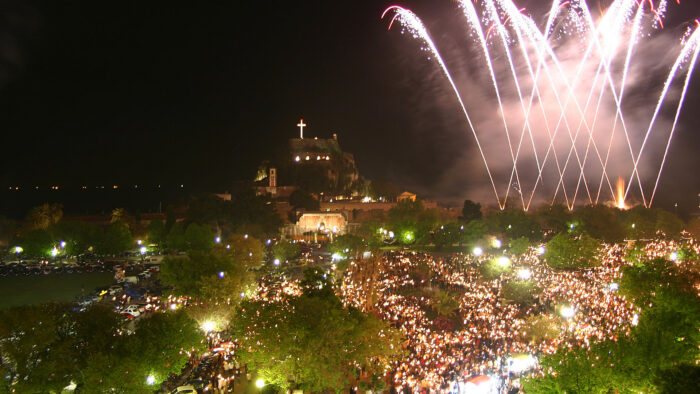
- Easter Celebrations: Known for the “Pot Throwing” tradition and vibrant processions. Orthodox Easter (April/May)
- Corfu Carnival (Apokries): Inspired by Venetian traditions, featuring costumes, parades, and street parties. February/March
- Corfu International Festival: Showcases various performing arts, promoting cultural exchange. August and September feature music, theater, and dance performances from international and local artists.
- Varkarola Festival: Celebrates Corfu’s naval history with boat parades and traditional music. August 11th (Paleokastritsa)
- Corfu Beer Festival: Features local craft beers and traditional Greek cuisine. September
- International Music Festival: Attracts musicians for classical performances. September/October
Are there any Beaches in Corfu Town?
While Corfu Old Town may not be the ideal destination for beach enthusiasts, there are a few smaller “city beaches” in the area where you can enjoy a swim. These spots are relatively compact and may not be the most child-friendly, but they offer a chance to cool off while exploring Corfu Town. Here’s a closer look at some of these options:
Faliraki Promontory
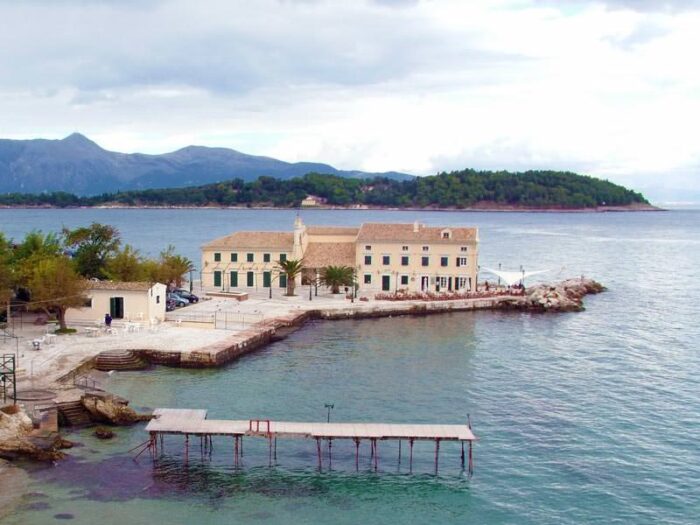
Faliraki, also known as Aleko’s Baths, is a public beach situated below the Palace at Faliraki Promontory. Accessed via a small road from Arsenios Street, this beach has a modest entrance fee, lower than Mon Repos.
While the beach is small and less ideal for swimming, especially when waves are stirred up by passing boats, it offers stunning views of the Palace, the Old Fortress, and Vido Island. There’s also a bar and restaurant on-site where you can enjoy food and drinks.
The facilities of NAOK (Nautical Sports Club of Corfu)

The Nautical Athletic Group of Kerkyra (NAOK) is an athletic club specializing in water sports like swimming, rowing, and sailing. Located on the south side of the Old Fortress, NAOK provides various amenities related to water sports, though it does not have a traditional beach. The club offers:
- Sailing School: Learn sailing techniques and receive certifications.
- Boat Rental: Rent boats and equipment for sailing, windsurfing, and other water sports.
- Storage and Moorings: Safe storage for boats and moorings for members’ vessels.
- Clubhouse: Relaxation and social areas with dining facilities.
- Marina Services: Fueling, maintenance, and washing services for boats.
- Water Sports Equipment: Rental of equipment for activities like windsurfing and kayaking.
- Regatta and Racing Events: Participate in or watch regattas and sailing races.
- Training and Coaching: Programs for various water sports disciplines.
- Social Events: Gatherings, parties, and events for members.
- Bar and Restaurant: Enjoy meals and refreshments on-site.
Mon Repos Beach
Mon Repos Beach is located near the neoclassical Mon Repos Palace at the south end of Garitsa Bay. This pebble beach offers a serene atmosphere and crystal-clear waters. Surrounded by lush greenery, it provides a peaceful retreat from the city’s hustle and bustle. The beach is notable for its historical significance as the birthplace of Prince Philip, Duke of Edinburgh, in 1921.
Anemomylos
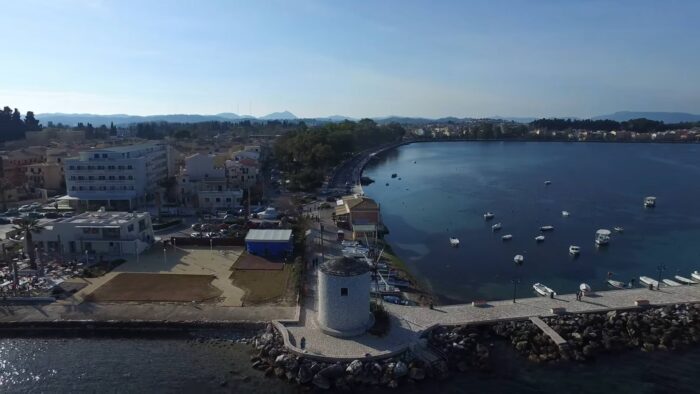
Anemomylos, meaning “Windmill” in Greek, overlooks Garitsa Bay and the Ionian Sea. While the windmill is a historical landmark reflecting Corfu’s agricultural past, the nearby jetty serves as a spot for swimming. Though not a traditional beach, the area features a rocky shoreline with some shingles and offers beautiful, scenic views.
The Beach at Kanoni Peninsula
Kanoni Beach, located in the Kanoni area, is a small pebble beach with clear waters. Although it’s not a large sandy beach, it provides a beautiful setting and a chance to relax. The beach offers stunning views of Pontikonisi (Mouse Island) and the Vlacherna Monastery. Additionally, visitors can enjoy watching planes land and take off from the nearby Corfu International Airport.
Tips for Your Journey to Kerkyra
Traditional Corfiot Dishes
- Pastitsada: A hearty dish made with pasta and a rich tomato-based meat sauce, usually served with beef or rooster.
- Sofrito: Thin slices of beef cooked in a white wine and garlic sauce, often served with rice or potatoes.
- Bourdeto: A spicy fish stew made with scorpionfish and lots of paprika.
Best Places to Eat
- Avli: Located in a charming courtyard, this restaurant serves up traditional Corfiot cuisine with a modern twist.
- Rex: One of the oldest restaurants in Corfu, famous for its authentic dishes and historic setting.
- Pane e Souvlaki: For something more casual, this popular eatery offers Greek street food like souvlaki and gyros.
Shopping in the Old City
Corfu’s Old Town offers a charming shopping experience that reflects its rich history and vibrant local culture. Here’s what you can find:
Local Markets
- Corfu Town Market: Located in the heart of the Old Town, this bustling market is perfect for picking up local produce, cheeses, olives, and spices. It’s a great place to experience the local atmosphere and taste authentic Greek flavors.
Artisanal Shops
- Mastihashop: Specializing in mastiha (mastic resin), a unique product from Chios Island, this shop offers a range of products from cosmetics to sweets that showcase this traditional ingredient.
- Corfu Handmade Leather: Find handcrafted leather goods including shoes, bags, and belts. Each item is made with attention to detail and reflects the island’s artisanal craftsmanship.
Unique Boutiques
- Melenia: This boutique features a selection of high-quality Greek and international fashion brands, offering stylish clothing and accessories in an elegant setting.
- Cultural Collections: Shops like “Cultural Collections” sell a variety of traditional Greek items such as handcrafted ceramics, textiles, and jewelry that make for perfect souvenirs.
Souvenir Shops
- The Greek Shop: Located near the Liston Promenade, this shop is known for its wide selection of Greek souvenirs including worry beads, local wines, and olive oil products.
Local Delicacies
- Siora: For those looking to take home some local flavors, Siora offers a range of artisanal products including local wines, honey, and traditional sweets like kumquat liqueur and pasteli.
Exploring these shops provides a wonderful opportunity to take a piece of Corfu’s charm home with you, whether you’re looking for unique gifts, local delicacies, or a taste of the island’s rich traditions.
Best Shopping Streets
- Nikiforou Theotoki Street: A bustling street filled with boutiques, souvenir shops, and local artisan stores.
- Guilford Street: Known for its high-end shops and designer boutiques.
Nightlife and Entertainment
Bars and Cafés
- Bristol Café: A stylish café-bar with a retro vibe, perfect for evening drinks.
- Cafe Kanoni: Located near the airport, it offers stunning views of the landing planes and the nearby Pontikonisi Island.
Day Trips from Corfu Old Town
Paleokastritsa
- Overview: A picturesque village about 25 km from Corfu Town, known for its stunning beaches and the 13th-century monastery of Theotokos.
- Activity: Take a boat trip to explore the nearby caves.
Achilleion Palace
- Overview: The summer palace of Empress Elisabeth of Austria, also known as Sisi. The palace is a blend of classical and neoclassical styles and is set amidst beautiful gardens.
- Highlight: The statue of Achilles, which reflects the Empress’s admiration for the Greek hero.
Mouse Island (Pontikonisi)
- Overview: A small, lush island near the coast, known for its monastery and as a symbol of Corfu. It’s a short boat ride from Kanoni.
- Tip: Visit early in the morning to avoid the crowds and enjoy the tranquility.
Practical Tips for Visitors
Best Time to Visit
- Spring (April to June): Pleasant weather and fewer tourists. Easter is a special time with unique traditions.
- Summer (July to August): Peak season with warm weather, perfect for beach activities.
- Fall (September to October): Mild weather and fewer crowds, ideal for sightseeing.
Getting Around
- On Foot: The Old Town is best explored on foot. The narrow streets and hidden alleys are pedestrian-friendly.
- Public Transport: Buses connect the Old Town with other parts of the island. There’s also a small tourist train for a quick overview of the main sights.
- Taxis and Car Rentals: Available but not necessary unless you plan to explore the island’s more remote areas.
Where to Stay
- Luxury: Bella Venezia Hotel – A charming boutique hotel in a restored neoclassical mansion.
- Mid-Range: Siorra Vittoria Boutique Hotel – A historic mansion with elegant rooms and a beautiful garden.
- Budget: Locandiera – A cozy guesthouse located in a quiet street in the heart of the Old Town.
Insider Tips
- Early Morning or Late Evening Strolls: To experience the Old Town without the crowds, explore early in the morning or after sunset.
- Photography: The best spots include the Old Fortress, the Liston, and the view from the New Fortress.
- Local Festivals: Check the local calendar for festivals and events that may offer a deeper cultural experience.
The Modern City of Corfu
The contemporary city of Corfu seamlessly extends from the historical Corfu old town, stretching westward and southward beyond the new fortress into an expansive urban expanse that envelops the core of the island’s eastern coastline.
It presents a stark departure from the old quarter, characterized by the prevalence of concrete constructions and broader thoroughfares.
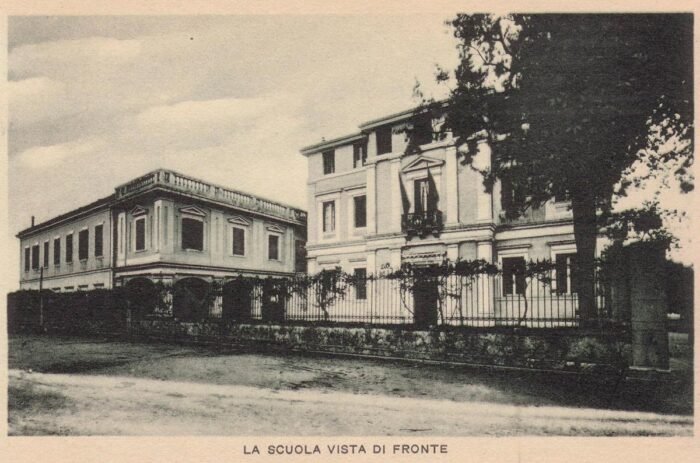
However, amidst this modern landscape, vestiges of old neoclassical structures and other monuments remain, offering a connection to the city’s historical roots.
For instance:
- The edifice of the 1st Gymnasium, originally the Scaramanga building and former home to the Italian School.
- The Marasleion Mansion, situated on Alexandra Avenue, currently houses the services of the City Hall.
- The Villa Rosa is an exquisite yet forsaken structure that stands near San Rocco Square, its splendor now marred by abandonment and decay.
- An array of ancient churches is representative of the many ecclesiastical edifices found within the city.
These remnants serve as testaments to the city’s intricate past, complementing the contemporary visage of Corfu while maintaining a bridge to its historical heritage.
Corfu Old Town Map
A Map of the old Corfu town section is necessary for your Corfu walking adventures.

Wrapping Up
Corfu Old Town is not just a place; it’s an experience, a living museum where every corner tells a story.
From its medieval fortresses to its narrow alleyways, from Venetian arches to Byzantine walls, Corfu Old Town invites you to step back in time and immerse yourself in its rich, multifaceted heritage.
This guide has taken you through some of the most iconic landmarks and hidden gems in the town, offering a glimpse into the town’s fascinating past and its lively present.
Whether you’re a history enthusiast, a lover of architecture, or simply looking for a beautiful place to unwind, Corfu Old Town has something to offer everyone.







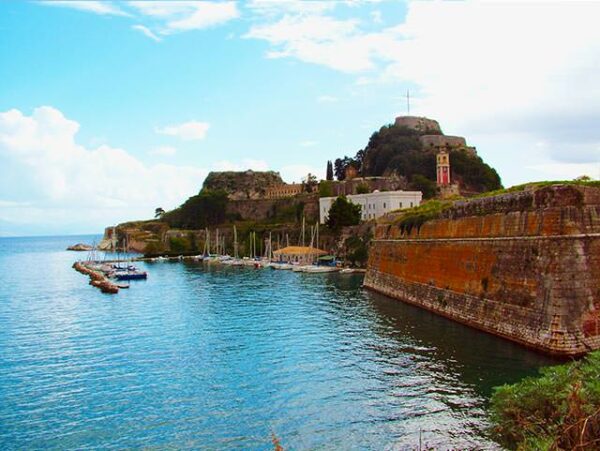


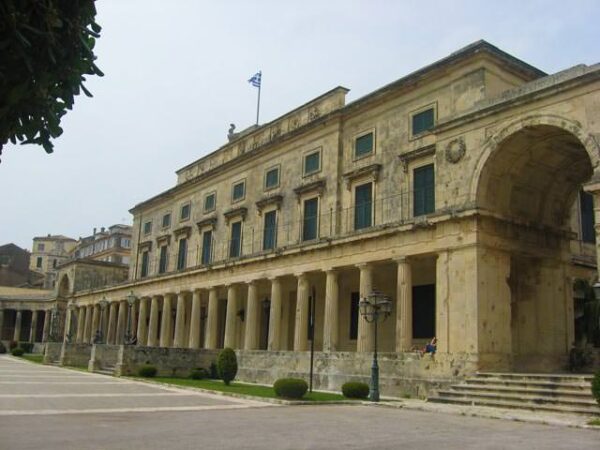
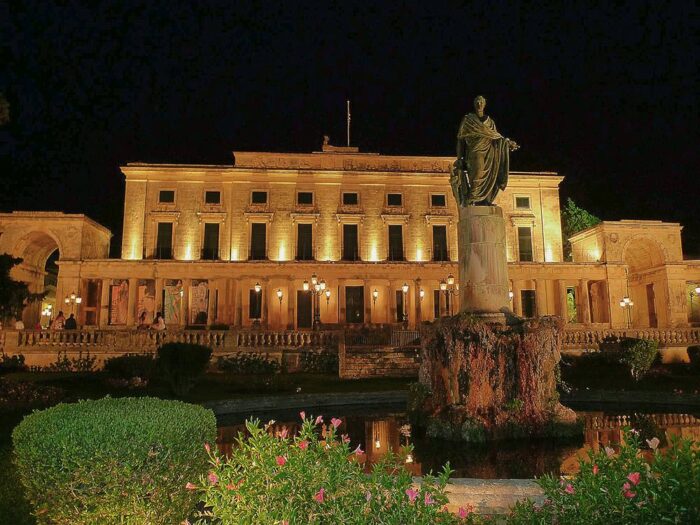

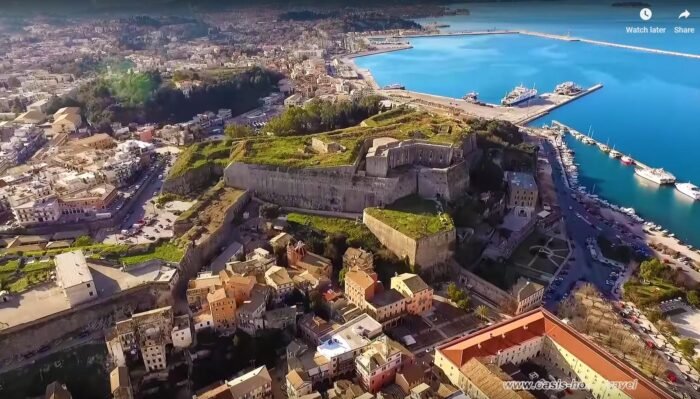


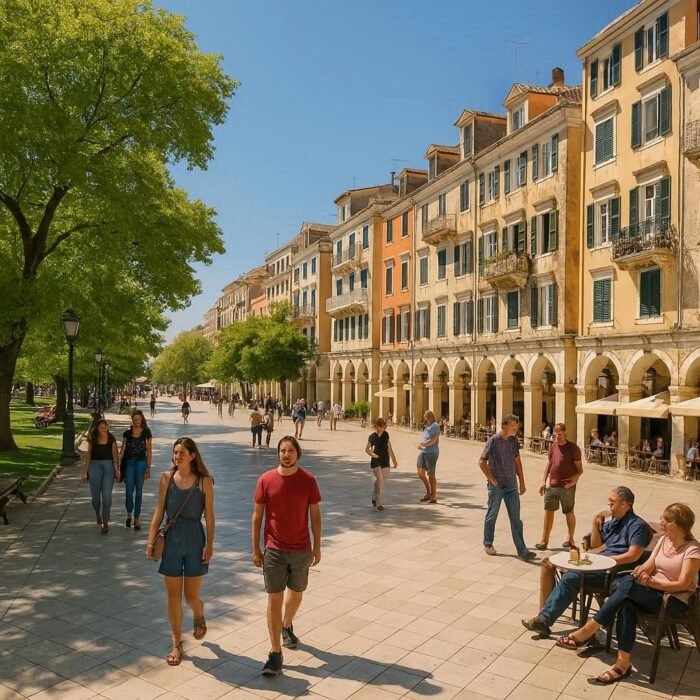

Comments